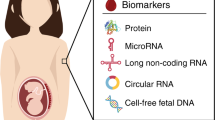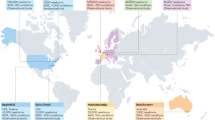Abstract
Clinical applications of prenatal genetic screening currently focus on detection of aneuploidy and other genetic diseases in the developing fetus. Growing evidence suggests that the fetal genome may also be informative about fetal exposures through contributions to placental transport as well as placental and fetal metabolism. Possible clinical applications of prenatal pharmacogenomic screening include prospective optimization of medication selection and dosage, as well as retrospective assessment of whether a fetus was previously exposed to significant risk. Newly available noninvasive methods of prenatal genetic screening mean that relevant fetal genotypes could be made available to obstetricians for use in management of a current pregnancy. This promising area for research merits more attention than it has thus far received.
This is a preview of subscription content, access via your institution
Access options
Subscribe to this journal
Receive 6 print issues and online access
$259.00 per year
only $43.17 per issue
Buy this article
- Purchase on Springer Link
- Instant access to full article PDF
Prices may be subject to local taxes which are calculated during checkout
Similar content being viewed by others
References
Kitzman JO, Snyder MW, Ventura M, Lewis AP, Qiu R, Simmons LE et al. Noninvasive whole-genome sequencing of a human fetus. Sci Transl Med 2012; 4: 137ra76.
Dondorp W, de Wert G, Bombard Y, Bianchi DW, Bergmann C, Borry P et al. Non-invasive prenatal testing for aneuploidy and beyond: challenges of responsible innovation in prenatal screening. Eur J Hum Genet 2015; 23: 1592.
Mitchell AA, Gilboa SM, Werler MM, Kelley KE, Louik C, Hernandez-Diaz S et al. Medication use during pregnancy, with particular focus on prescription drugs: 1976-2008. Am J Obstet Gynecol 2011; 205: 51, e1–e8.
Adam MP, Polifka JE, Friedman JM . Evolving knowledge of the teratogenicity of medications in human pregnancy. Am J Med Genet C Semin Med Genet 2011; 157C: 175–182.
Daud AN, Bergman JE, Bakker MK, Wang H, de Walle HE, Plosch T et al. Pharmacogenetics of drug-induced birth defects: the role of polymorphisms of placental transporter proteins. Pharmacogenomics 2014; 15: 1029–1041.
Olagunju A, Owen A, Cressey TR . Potential effect of pharmacogenetics on maternal, fetal and infant antiretroviral drug exposure during pregnancy and breastfeeding. Pharmacogenomics 2012; 13: 1501–1522.
Manuck TA . Pharmacogenomics of preterm birth prevention and treatment: a review. BJOG 2015; 123: 368–375.
Krishnamurthy P, Schuetz JD . Role of ABCG2/BCRP in biology and medicine. Annu Rev Pharmacol Toxicol 2006; 46: 381–410.
Giacomini KM, Balimane PV, Cho SK, Eadon M, Edeki T, Hillgren KM et al. International Transporter Consortium commentary on clinically important transporter polymorphisms. Clin Pharmacol Ther 2013; 94: 23–26.
Maeno Y, Hirose A, Kanbe T, Hori D . Fetal arrhythmia: prenatal diagnosis and perinatal management. J Obstet Gynaecol Res 2009; 35: 623–629.
Hakkola J, Pelkonen O, Pasanen M, Raunio H . Xenobiotic-metabolizing cytochrome P450 enzymes in the human feto-placental unit: role in intrauterine toxicity. Crit Rev Toxicol 1998; 28: 35–72.
Leeder JS, Gaedigk R, Marcucci KA, Gaedigk A, Vyhlidal CA, Schindel BP et al. Variability of CYP3A7 expression in human fetal liver. J Pharmacol Exp Ther 2005; 314: 626–635.
Nakachi K, Imai K, Hayashi S, Kawajiri K . Polymorphisms of the CYP1A1 and glutathione S-transferase genes associated with susceptibility to lung cancer in relation to cigarette dose in a Japanese population. Cancer Res 1993; 53: 2994–2999.
Wang X, Zuckerman B, Pearson C, Kaufman G, Chen C, Wang G et al. Maternal cigarette smoking, metabolic gene polymorphism, and infant birth weight. JAMA 2002; 287: 195–202.
Acknowledgements
This research was supported in part by grant # U01 GM092676 from the National Institute of General Medical Sciences and the National Institutes of Health and grant #U10 HD047892 from the Eunice Kennedy Shriver National Institute of Child Health & Human Development and the National Institutes of Health. The content is solely the responsibility of the authors and does not necessarily represent the official views of the National Institute of General Medical Sciences, the Eunice Kennedy Shriver National Institute of Child Health & Human Development or the National Institutes of Health.
Author information
Authors and Affiliations
Corresponding author
Ethics declarations
Competing interests
The authors declare no conflict of interest.
Rights and permissions
About this article
Cite this article
Dorfman, E., Cheng, E., Hebert, M. et al. Prenatal pharmacogenomics: a promising area for research. Pharmacogenomics J 16, 303–304 (2016). https://doi.org/10.1038/tpj.2016.33
Received:
Revised:
Accepted:
Published:
Issue Date:
DOI: https://doi.org/10.1038/tpj.2016.33
This article is cited by
-
Drug dosing during pregnancy—opportunities for physiologically based pharmacokinetic models
Journal of Pharmacokinetics and Pharmacodynamics (2020)



